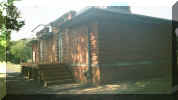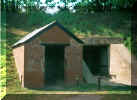The History of Fort Mott
Introduction
Fort Mott, an Endicott-era fortification was built as part of the federal government's late 19th Century
plan to defend the Delaware River. Today it serves as a state park where visitors can tour the remnants
of the historic fort. The cultural and historic features of this park and its recreational facilities provide a
unique blend of activities for the park visitor. Fort Mott State Park is included
as a historic site on the
New Jersey Coastal Heritage Trail. A Welcome Center for the trail accommodates displays defining Fort
Motts place in history and the maritime environment. Fort Mott State Park is on the Delaware River at
Finns Point in Salem County, New Jersey. This 104 acre park is six miles south of the Delaware River
Memorial Bridge, off New Jersey Route 49.
History
 The Finns Point Reservation was purchased by the United States Government in the late 1830s. Originally
called "The Battery at Finns Point", the proposed fortification was one of a three-fort plan to protect growing
industries and shipping along the Delaware River. Plans for Finns Point specified eleven gun emplacements
with twenty guns and a mortar battery with six emplacements. With Fort Delaware on Pea Patch Island in
operation since the early 1820's and the nation involved in the civil War, the construction of the
Battery at
Finns Point was delayed until 1872. At that time only two gun emplacements and five magazines in the
mortar battery were completed before construction was halted because of budgetary constraints.
The Finns Point Reservation was purchased by the United States Government in the late 1830s. Originally
called "The Battery at Finns Point", the proposed fortification was one of a three-fort plan to protect growing
industries and shipping along the Delaware River. Plans for Finns Point specified eleven gun emplacements
with twenty guns and a mortar battery with six emplacements. With Fort Delaware on Pea Patch Island in
operation since the early 1820's and the nation involved in the civil War, the construction of the
Battery at
Finns Point was delayed until 1872. At that time only two gun emplacements and five magazines in the
mortar battery were completed before construction was halted because of budgetary constraints.
With advancements in military technology made during the Civil War and in the post Civil War period,
the United States defenses were dangerously inadequate. In 1885, President Grover Cleveland, at the
request of Congress, appointed the Endicott Board, named after its chairman William Endicott the
Secretary of War. The board, which consisted of both military men and private citizens, studied the
existing coastal defenses and developed a coastal defense plan for the United States. This plan determined where defenses should be built or improved, the order in which the work would proceed, the
quantity and type of guns that would lie placed at each fort, and other considerations.
 The main defensive concept of the Delaware River was the dispersion of armaments into three separate
fortifications. The original plan for the Battery at Finns Point was abandoned and
construction of new
fortifications began in 1896 in anticipation of war with Spain, the Spanish - American War. This
fortification was officially re-named Fort Mott on December 16,1897, to honor Major General
Gershom Mott (April 7, 1822 - November 29, 1884). Mott a native of Bordentown, New Jersey, was a
decorated veteran of the Mexican American and Civil Wars. Fort Delaware was upgraded and construction of
Fort DuPont began during this same time period.
The main defensive concept of the Delaware River was the dispersion of armaments into three separate
fortifications. The original plan for the Battery at Finns Point was abandoned and
construction of new
fortifications began in 1896 in anticipation of war with Spain, the Spanish - American War. This
fortification was officially re-named Fort Mott on December 16,1897, to honor Major General
Gershom Mott (April 7, 1822 - November 29, 1884). Mott a native of Bordentown, New Jersey, was a
decorated veteran of the Mexican American and Civil Wars. Fort Delaware was upgraded and construction of
Fort DuPont began during this same time period.
At Fort Mott large caliber weapons, three 10-inch and three 12-inch guns were installed on disappearing
carriages. The gun emplacements were located behind a 750 fool long and 35 foot thick concrete and earthen
embankment, which was sloped to form the "parapet" wall. These guns had an affective range of seven to
eight miles and shot projectiles that weighed 617 and 1000 pounds respectively. Beneath the six gun
platforms were powder and shell magazines, ammunition hoists, telecommunications
system, and an electric
generating station, two batteries each with 5-inch rapid fire guns, and one battery with two 3-inch rapid
fire guns were also part of the defenses, designed to counter fast moving smaller warships, which might evade
the large caliber guns. They also protected the fort from potential land attack. Fort Mott was a completely
modern installation for this time period.
 Two steel control towers were later built to improve aiming of the guns. Observers stationed in the
towers in conjunction with plotting room personnel directed the gunfire of the 10-inch and 12-inch
guns. The tower by the river on the northern end of the emplacement was built in 1902 and used to
aim the 12-inch guns of Battery Arnold. The towel neat the park office was built in 1903 to help fort
personnel aim the 10-inch guns of Battery Harker.
Two steel control towers were later built to improve aiming of the guns. Observers stationed in the
towers in conjunction with plotting room personnel directed the gunfire of the 10-inch and 12-inch
guns. The tower by the river on the northern end of the emplacement was built in 1902 and used to
aim the 12-inch guns of Battery Arnold. The towel neat the park office was built in 1903 to help fort
personnel aim the 10-inch guns of Battery Harker.
Behind the main emplacement are the parados and the moat. Parados is Spanish for rear door. These provided
the rear defenses for the fort. The parados was constructed using fill form the moat. Landscaping around
the military reservation helped camouflage Fort Mott from attack from potential enemy ships.
Fort Mott was a self-contained military community. The post had over 30 buildings, including two large
barracks, commissioned and non-commissioned officers housing, hospital, a post exchange, a library, a
guard house, a stable, YMCA and a school for the soldier's children. The Delaware River was the main transportation infrastructure for Fort Mott;
munitions, supplies, and construction materials
arrived at the fort by barge.
With the construction of Fort Salisbury near
Milrord, Delaware shortly before World War
I, Fort Mott, Fort Delaware, and Fort
DuPont became obsolete, the three forts
remained active defense installations until
after World War II, when they were phased
out. Troops were regularly stationed at Fort
Mott from 1897 to 1922. The federal government maintained a care taking detachment at
the fort from 1922 to 1943. During this
time, Fort Mott's guns were dismantled and
sent to various locations.
Fort Mott was declared "surplus property" in
1943. Finn's Point National Cemetery (Dedicated a National Cemetery on October 3, 1873
because of the Confederate prisoners of war
buried there) was separated from Fort Mott at
that time. In 1947, the State of New Jersey
purchased Fort Mott, as a historic site, from the
federal government. On June 24, 1951, it
opened to the public, as Fort Mott State Park.
 Copyright © 2001-
, Terry Muse
Copyright © 2001-
, Terry Muse
Revised: October 8, 2001
URL: http://www.coastalheritagetrail.tripod.com
Contact: Terry Muse
Coastal Heritage Trail | Delsea Region
 The Finns Point Reservation was purchased by the United States Government in the late 1830s. Originally
called "The Battery at Finns Point", the proposed fortification was one of a three-fort plan to protect growing
industries and shipping along the Delaware River. Plans for Finns Point specified eleven gun emplacements
with twenty guns and a mortar battery with six emplacements. With Fort Delaware on Pea Patch Island in
operation since the early 1820's and the nation involved in the civil War, the construction of the
Battery at
Finns Point was delayed until 1872. At that time only two gun emplacements and five magazines in the
mortar battery were completed before construction was halted because of budgetary constraints.
The Finns Point Reservation was purchased by the United States Government in the late 1830s. Originally
called "The Battery at Finns Point", the proposed fortification was one of a three-fort plan to protect growing
industries and shipping along the Delaware River. Plans for Finns Point specified eleven gun emplacements
with twenty guns and a mortar battery with six emplacements. With Fort Delaware on Pea Patch Island in
operation since the early 1820's and the nation involved in the civil War, the construction of the
Battery at
Finns Point was delayed until 1872. At that time only two gun emplacements and five magazines in the
mortar battery were completed before construction was halted because of budgetary constraints.


